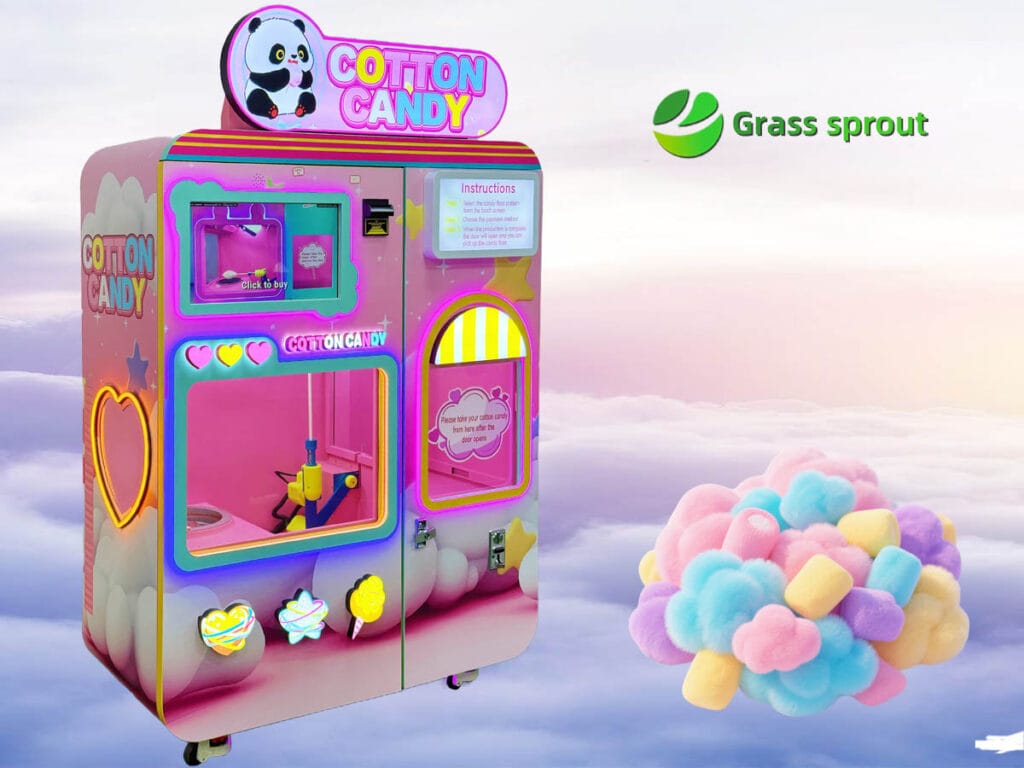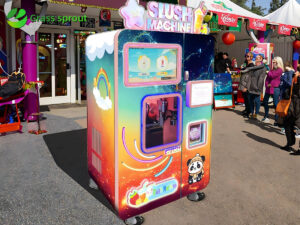Cotton candy has been a kid (and kid at heart) favorite since time immemorial. While it used to be synonymous with the fair/carnival midway, many people now make it at home or work with automatic cotton candy machines, including self-service vending units. But if you’ve never spun sugar before, just how do you make cotton candy with a machine? What do you need for consistency and top quality?
Are you an entrepreneur looking at getting into the cotton candy business? Perhaps a newcomer just wondering how it all works? Either way, we’ll take you step by step through the entire process—from sugar choice to final spinning.

Step 1: Choose the Right Sugar
The right type of sugar is crucial to success with cotton candy, including performance and safety with your machine.
Key Requirements:
- Granule Size: Use a granulated sugar with particles approximately 1–2mm in diameter. Powdered sugar is too fine (melts too fast) while very coarse crystals will have trouble spinning.
- Dryness: It is important that the sugar be completely dry. Moisture or clumping results in poor spinning performance and can damage the heating element.
Sugar should always be stored in sealed, airtight containers—particularly in humid climates or near water sources.
Step 2: Add Color and Flavor for Visual Appeal
otton candy is also about colors and flavors. People don’t just want a pile of sugar in the shape of a cone. If you have multiple serving stations, or especially automated vending machines, having options available goes a long way to customer satisfaction.
Common Flavor Colors Include:
- 🔴 红色 – Often strawberry
- 🟡 黄色 – Typically pineapple or lemon
- 🔵 蓝色 – Usually blue raspberry
- ⚪ 白色 – Often vanilla
- 🟣 紫色 – Commonly grape
- 🟢 绿色 – Frequently apple or lime
The colors allow for visual presentation of the final cotton candy. They also help users quickly identify which flavor they want without confusion. Some machines also allow multiple flavor selections in one batch, or even spinning fun patterns of multiple colors.

Step 3: Preheat the Machine
As with any mechanical system, the cotton candy machine needs time to reach operating temperature
- Preheat for several minutes (depending on the machine).
- Most machines will have an automatic (or manual) indicator light to show when they are ready to go.
Failure to preheat can result in uneven spinning, wasted sugar, and/or equipment malfunction.
Step 4: Dispense the Sugar
With the machine hot and ready, the sugar can be added into the spinning head. Manual machines are typically filled by hand. Self-service vending machines have an automated system to measure and dispense the correct amount of sugar into the spinning head based on serving size and user selection.
- Use about 1–2 tablespoons (10–20g) per serving.
- Do not overload the machine. Overfilling may lead to splattering or clogs.
Automatic vending operations are set up with an automated sugar dispenser for pre-measured, consistent servings of sugar.
Step 5: Spinning and Forming the Cotton Candy
Once the sugar is added:
- The spinning head is heated, and the sugar melts to a liquid.
- This liquid is pushed out of the spinning head through many tiny holes by centrifugal force.
- This molten sugar is projected into the air, where it cools and forms into tiny threads.
- A stick or cone is used to catch the spun sugar as it collects into a cloud-like mass.
Automatic vending machines are fully enclosed (no spinning parts exposed), and the user simply waits as the candy is formed (about 45 to 90 seconds depending on machine size). The only operator interaction is dispensing and collecting the cotton candy.
Step 6: Serving and Hygiene Considerations
Manual or automatic, hygiene is a consideration for commercial and vending operations.
- Use single-use paper sticks or food-grade holders.
- Machines should have the spinning head and internal components cleaned regularly to prevent buildup of old sugar.
- Fully enclosed vending units further promote hygiene by not having direct human contact with the machine or spun sugar.
his is both about safety, but also cleanliness and color/visual appeal, which have a huge impact on the taste of cotton candy as well.
Why Use a Fully Automatic Cotton Candy Machine?
Manual operation is fine for small events or temporary locations. However, vending-style, automatic systems offer a range of advantages in high-traffic environments:
| Benefit | Manual Machine | Automated Machine |
| Requires Operator | ✅ Yes | ❌ No |
| Hygiene Level | ⚠️ Variable | ✅ Enclosed & Clean |
| Serving Speed | Medium (1–2 min) | Fast (45–90 seconds) |
| Flavor Variety | Usually 1–2 flavors | 6 or more options |
| Operating Hours | Limited by staff | 24/7 unattended |
For commercial businesses, vending-style machines reduce labor and training, increase reliability, and improve overall customer experience and satisfaction.
Suggested Image Placements
Include these images to make your blog visually pop:
- Macro shot of dry, colored sugar crystals (1–2mm)
- Display of six different cotton candy color flavors
- User operating a touch screen to select a flavor
- Spinning cotton candy forming in a clear machine dome
- Finished cotton candy served on sticks in multiple colors

Conclusion: From Simple Sugar to Sweet Success
Making cotton candy in a machine is really quite simple if you have the right sugar and procedures in place. By using the proper granule size (1–2mm), ensuring dry ingredients, and attractive flavoring options, anyone can consistently produce high-quality cotton candy that customers will love.
Automatic vending machines take it even further with benefits like hygiene, customization, and 24/7 service without any operator required.
📣 Call to Action
If you’re thinking about starting your own cotton candy business or expanding your venue with a new vending option,
Cotton Candy Machines For Sale Visit Now.
Now is the time to get serious about automated solutions to easily and profitably turn sugar into smiles.





